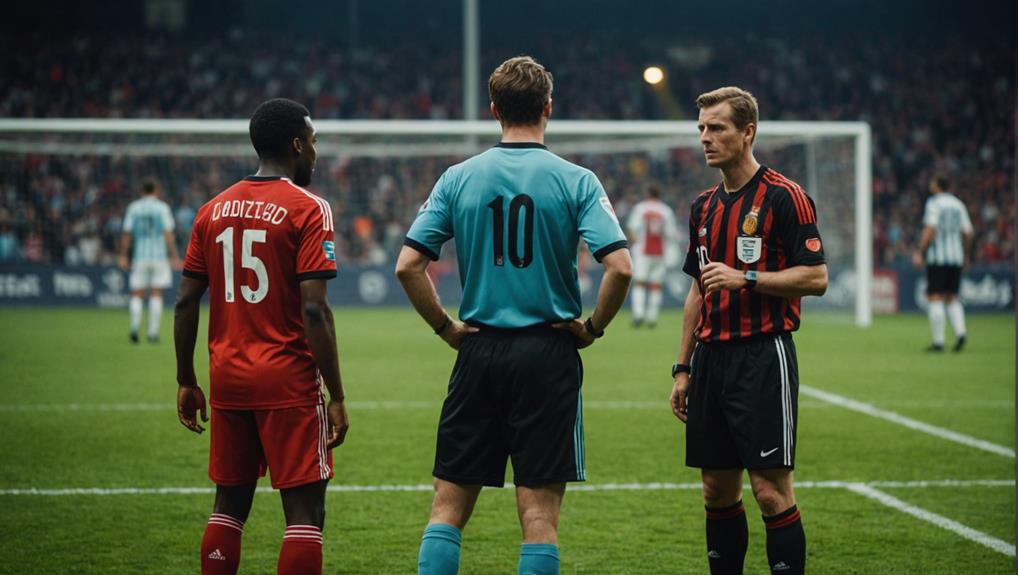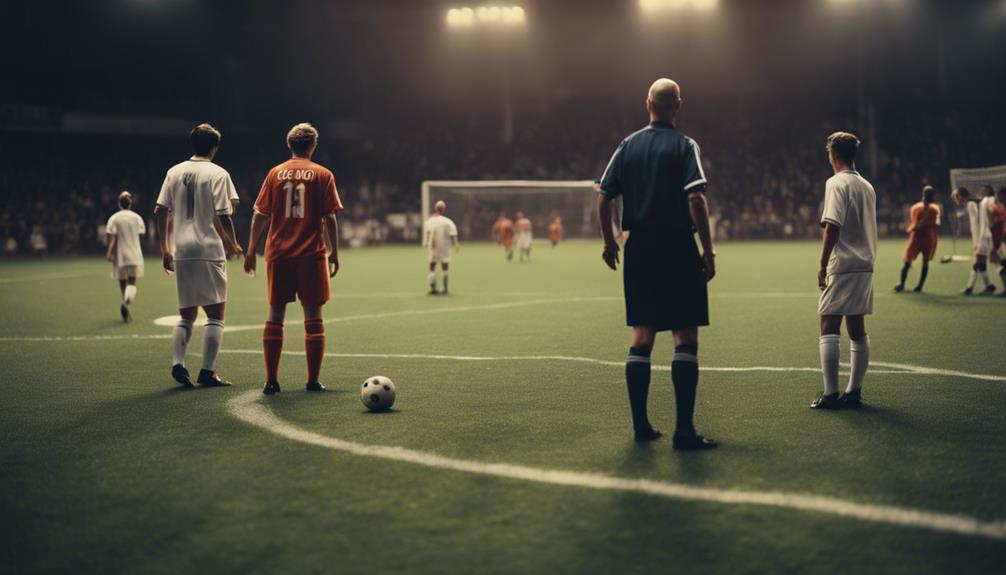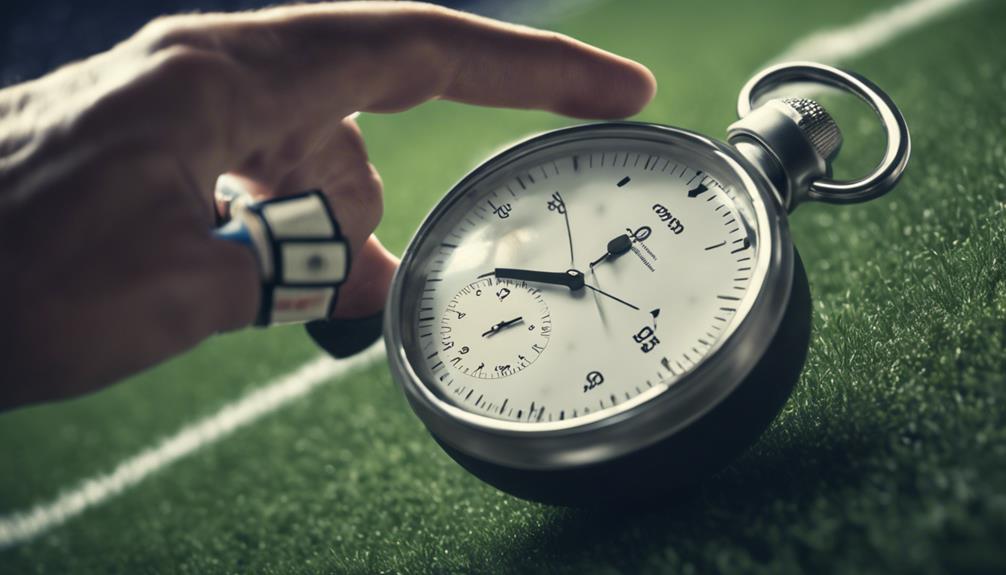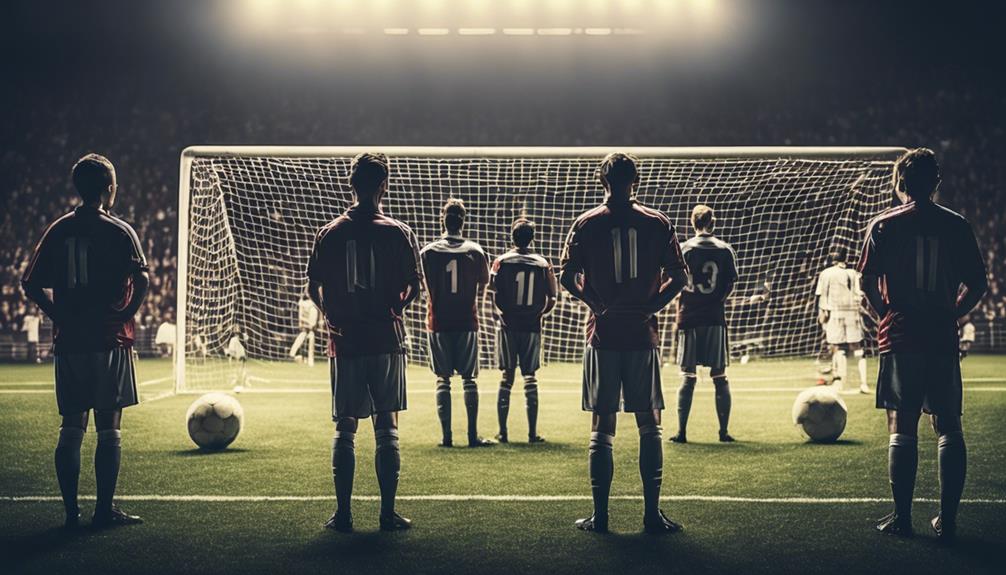
How Soccer Periods Work: An Overview
August 16, 2024If you're curious about how soccer periods unfold, here's a simple breakdown. A standard soccer match consists of two halves each lasting 45 minutes. Total game time can extend due to stoppage time for delays. In case of a tie, extra time might be added, and if still drawn, penalty shootouts settle the score. Halftime provides players a moment to rest, strategize, and make adjustments. Understanding these periods enhances your enjoyment of the game.
Field and Equipment
When stepping onto the soccer field, your gear and the field itself play essential roles in the game. The field is a rectangular area with specific dimensions and markings that define the boundaries of play.
At each end of the field, you'll find the goal, consisting of two vertical posts and a crossbar. These are positioned at the center of each goal line, serving as the ultimate target for scoring.
In terms of gear, players must suit up appropriately. This includes wearing shirts, shorts, socks, shin guards, and suitable footwear to guarantee safety and compliance with the rules.
When it comes to the soccer ball, it's spherical and made from synthetic leather, falling within a particular circumference range. Remember, for safety reasons, players are prohibited from wearing any dangerous materials or equipment during a match.
The Ball
You need to understand the specific regulations regarding the circumference of the ball and the materials used in its construction.
These factors are essential in ensuring fair and consistent gameplay.
Let's explore the technical specifications that influence the performance of the ball in soccer matches.
Ball Circumference Specifications
The official soccer ball's circumference must fall within the range of 27-28 inches (68-70 cm) according to FIFA regulations. Different age groups use varying ball sizes, like Size 3 for U8-U12 and Size 4 for U13-U16 players.
Youth leagues may opt for smaller sizes to match players' age and abilities. The weight range for official match balls typically spans 14-16 ounces (400-450 grams).
Maintaining proper inflation is crucial, with pressure requirements falling between 8.5 to 15.6 pounds per square inch (0.6 to 1.1 bars). Ensuring the soccer ball meets these specifications guarantees fair play and consistent performance on the field.
Be mindful of these standards when selecting a ball for training or competition, as they impact the game's dynamics and player experience. By adhering to FIFA's regulations, you contribute to the integrity and quality of soccer matches at all levels.
Ball Materials and Construction
Soccer balls, crafted from synthetic leather materials, undergo detailed construction processes to guarantee durability and performance on the field. The standard circumference of a soccer ball typically ranges from 27 to 28 inches, ensuring uniformity across matches. These balls are stitched around an inflated rubber-like bladder, which helps maintain their shape and pressure during gameplay.
It's vital to maintain the proper inflation pressure of the ball, which falls between 8.5 to 15.6 pounds per square inch, to optimize performance and playability. In cases where a ball is defective, it can be replaced during a game to uphold fairness and the integrity of the match.
Understanding the materials and construction of soccer balls is important for players, referees, and fans to appreciate the quality and standards maintained in the beautiful game.
Players and Officials

Within a standard soccer match, each team features 11 players on the field, including a goalkeeper, while a group of officials, led by the main referee, oversees the game's proceedings. A team must have a minimum of 7 players to avoid forfeiting the match. The main referee is supported by two assistant referees who assist in making offside calls and other decisions. Additionally, there's a 4th official who helps manage substitutions and other administrative tasks during the game.
In modern soccer, Video Assistant Referees (VAR) play an increasingly prominent role in ensuring fair play. VAR technology allows officials to review critical decisions by watching replays, which helps in making more accurate calls on goals, penalties, red cards, and mistaken identities.
The use of VAR aims to reduce errors that can impact the outcome of the game, contributing to a more just and equitable playing field for all teams involved.
Rules of Play
Let's talk about the ASPECTS in soccer rules of play.
Match Duration Rules dictate the length of gameplay and the potential for extra time.
Understanding Playing Field Specifics is essential for grasping the dynamics of the game,
and recognizing the Referee's Role Importance guarantees fair play and adherence to regulations.
Match Duration Rules
During a soccer match, the duration of play is divided into two halves, each lasting 45 minutes. In addition to regulation time, referees may add stoppage time to compensate for delays like injuries or substitutions.
If the game is tied after the regulation 90 minutes, extra time may be played, consisting of two 15-minute halves. Should the score remain level after extra time, penalties are awarded to determine the winner through a shootout.
Halftime provides a 15-minute break for players to rest, hydrate, and receive tactical instructions from coaches before resuming play. Substitutions are allowed during stoppages in play to replace players due to injuries, tactical changes, or fatigue.
Understanding the match duration rules is essential for both players and spectators to follow the flow of the game and anticipate potential outcomes based on the time remaining.
Playing Field Specifics
Understanding the rules governing the playing field in soccer is vital for players and spectators alike to grasp the intricacies of the game. The field dimensions are typically between 100-130 yards in length and 50-100 yards in width, providing a standardized area for matches.
Here are some key playing field specifics to keep in mind:
- The penalty boxes are pivotal areas in front of each goal, with the penalty spot located 12 yards away for penalty kicks.
- Goal lines mark the boundaries of the goal area, where teams aim to score while defending their own.
- Corner flags are strategically placed at each corner of the field to indicate where corner kicks are taken, offering teams scoring opportunities.
It's important for players to understand these field specifics to navigate the pitch effectively and execute strategic plays during matches.
Referee's Role Importance
The role of the referee in soccer is vital, as they're the ultimate authority on the field responsible for enforcing the rules of play. Referees hold the power to make pivotal decisions that can greatly impact the outcome of a match. Their enforcement of regulations guarantees fair play and upholds the principles of sportsmanship within the game.
Among the key responsibilities of a referee are awarding free kicks and penalties when rules are infringed upon. These decisions not only maintain order but also serve to deter foul play and uphold the integrity of the sport. Referees often collaborate closely with assistant referees to make sure that the game runs smoothly and that all rules are adhered to.
Respect for the referee's authority is fundamental in soccer, as it fosters a culture of sportsmanship and mutual respect among players, coaches, and spectators. Upholding the referee's decisions is essential for the overall enjoyment and fairness of the game.
Stoppage Time

Stoppage time in soccer is an essential component that addresses interruptions during a match. It guarantees that the game's duration accurately reflects the actual playing time by compensating for delays like injuries, substitutions, and time-wasting tactics.
Introduced in 1891 after a match between Stoke City and Aston Villa, where the referee added time for delays, stoppage time has become an integral part of the sport. Referees follow specific guidelines when determining added time, typically allocating around 30 seconds for a goal, 15 seconds for a substitution, and 15 seconds for a foul to make up for lost time.
This additional time can vary greatly, with the record for the most stoppage time added in a soccer match standing at an impressive 28 minutes. Ultimately, stoppage time plays a vital role in promoting fair competition and ensuring that matches reach a conclusive and just outcome.
Extra Time
You'll explore the added time allocation and overtime rules in soccer's extra time period.
This additional playing time can be critical in determining the outcome of a match.
The pressure intensifies as teams endeavor to break the deadlock and secure victory within these extra minutes.
Added Time Allocation
Added time allocation, also referred to as stoppage or injury time in soccer, serves to compensate for time lost during the match. Referees have the essential role of deciding how much added time is necessary to make up for any delays that occurred during the game.
This additional time guarantees that the full 90 minutes of gameplay are completed, even if there were interruptions along the way. The concept of added time was first introduced in 1891 after a match between Stoke City and Aston Villa faced significant delays, leading to the need for a fair way to extend play.
Referees typically add around 30 seconds for each goal scored. 15 seconds are commonly added for a substitution. An additional 15 seconds are usually allocated for a foul. The referee has the sole discretion to determine the total added time based on the specific circumstances of the game.
Overtime Rules
During extra time in soccer, two 15-minute halves are played if the game is tied after the standard 90 minutes. This period, also known as extra time, offers teams additional opportunities to secure a win before resorting to a penalty shootout.
To ensure fairness, teams switch sides after the first 15-minute period. The concept of overtime rules becomes particularly vital in knockout tournaments where advancing to the next round is dependent on breaking tied scores.
If the teams are still even after extra time, a penalty shootout is used to determine the winner. This method adds excitement and pressure as each team takes turns trying to outscore the other from the penalty spot.
Overtime not only tests the players' physical endurance but also their mental strength in high-stakes situations. Ultimately, the overtime rules are in place to provide a fair and definitive outcome when regular play can't break the deadlock.
Penalty Shootouts

In soccer, penalty shootouts are intense tie-breaker moments that occur when a game remains deadlocked after extra time.
During a penalty shootout:
- Each team takes five penalty kicks to determine the winner.
- If the score is still tied after the initial five kicks, the shootout enters sudden death, where teams take one kick each alternately until a winner is decided.
Penalty shootouts are known for being high-pressure situations, especially in knockout tournaments, as they determine which team advances to the next stage based on their performance in taking successful kicks under immense pressure.
In these nail-biting moments, players, coaches, and fans hold their breath as the fate of the game hangs on each kick, making penalty shootouts one of the most thrilling aspects of soccer competitions.
Soccer Basics
How are soccer matches typically structured regarding time and breaks for players?
Soccer matches are divided into two halves, each lasting 45 minutes, with a 15-minute break in between to allow players to rest and regroup.
If the game is tied at the end of regulation time, extra time is played, consisting of two 15-minute halves.
In cases where a winner must be determined, a penalty shootout occurs.
The referee is responsible for managing the time during the game, including adding stoppage time for injuries or other delays. This allows for fair play and ensures that the game progresses smoothly.
Understanding these basic elements of soccer timing and breaks is important for both players and spectators to follow the flow of the game effectively.
Rules and Officiating

Enforcing rules and making critical decisions, one referee and two linesmen officiate soccer matches to guarantee fair play and game integrity. The referee is responsible for overseeing the match, interpreting and enforcing the rules, while the linesmen assist in determining offside calls.
Here are some key aspects related to rules and officiating in soccer:
- Free Kicks and Penalties: Fouls committed by players can result in either a direct or indirect free kick, or even a penalty kick, depending on the severity and location of the offense.
- Yellow Cards and Red Cards: To maintain discipline on the field, referees may issue yellow cards as warnings or red cards for serious infractions, leading to player ejections.
- Offside Rule: Designed to prevent players from gaining an unfair advantage, the offside rule dictates when a player is in an offside position during an attacking play.
Training and Skills Development
Referees and coaches play vital roles in soccer matches, ensuring fair play and enforcing rules, while simultaneously contributing to players' training and skills development. Coaches are pivotal in player development, creating tailored training programs to address individual needs.
Specialized training is necessary for goalkeepers to enhance reflexes, positioning, and distribution skills. Improving soccer skills like ball control, passing accuracy, and shooting techniques requires consistent practice.
Additionally, selecting proper equipment such as cleats and shin guards is essential for best performance and injury prevention on the field. Advancing in soccer demands dedication to training, skill refinement, and understanding the tactical aspects of the game.
Conclusion
You've now mastered the basics of soccer periods! Remember, these high-energy halves are filled with non-stop action and excitement.
So get out there, kick some goals, and dominate the field like a pro! Just imagine yourself scoring the winning goal in the championship game – the crowd goes wild, you're a hero – that's the power of soccer periods!


